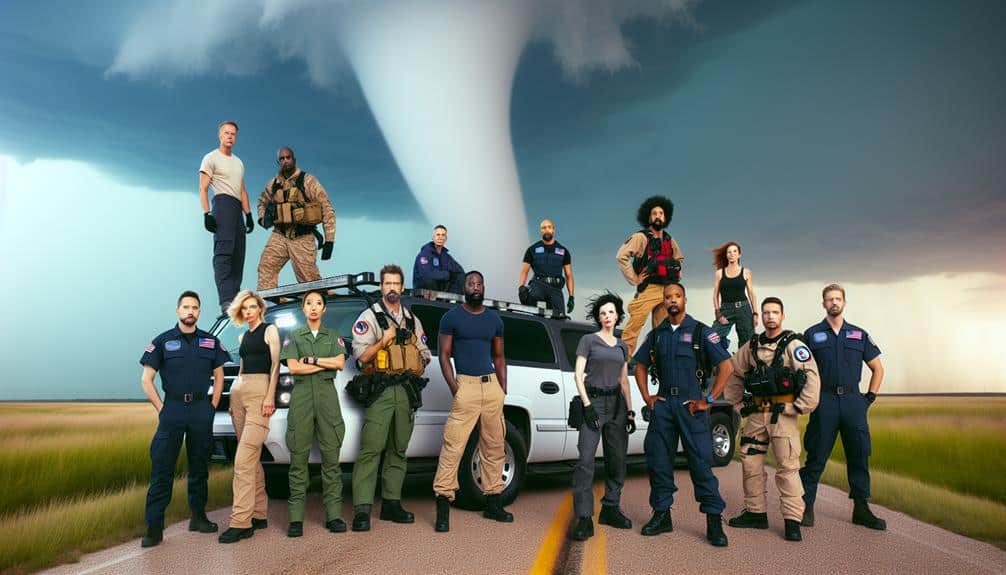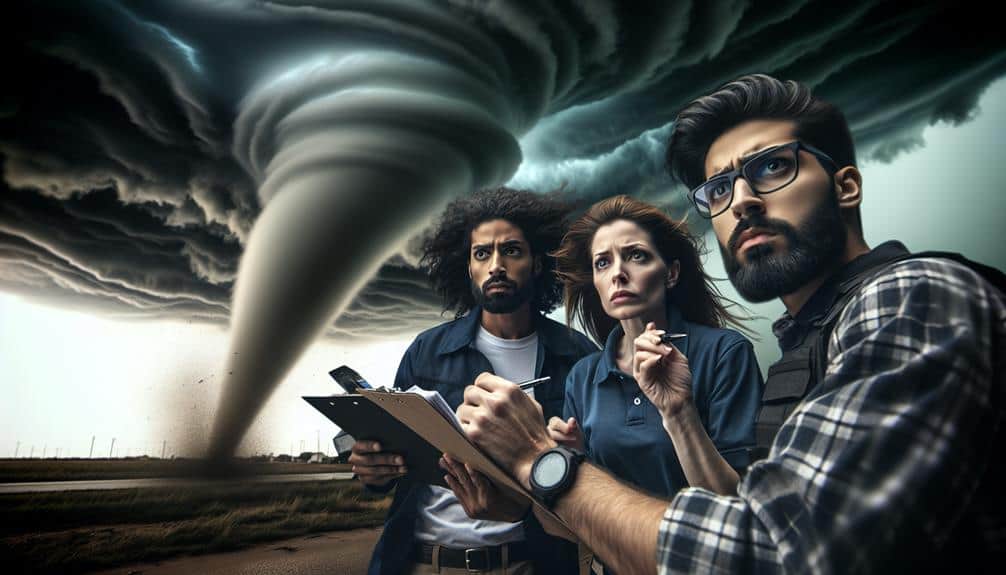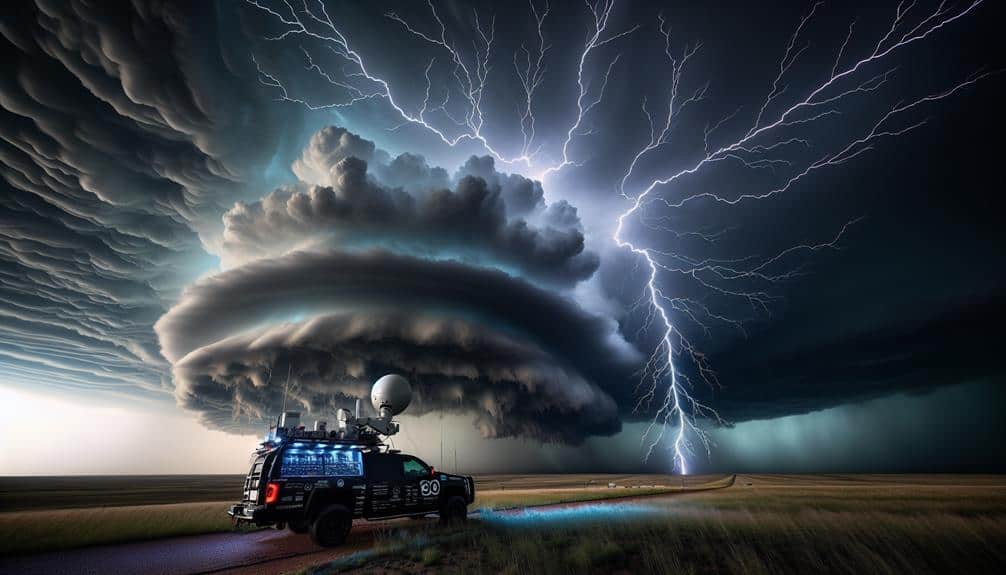We prioritize transparency in storm chasing tours to build trust with our clients by openly communicating about risks, safety protocols, and operational procedures. Our commitment to rigorous safety standards includes using cutting-edge meteorological instruments and GPS for real-time storm tracking. We guarantee ethical wildlife interactions by maintaining safe distances and practicing Leave No Trace principles. By providing precise, high-resolution weather data and honest marketing practices, we empower participants with the knowledge they need for their safety and immersive engagement. This integrated approach enhances client confidence and prepares them for the enthralling experience ahead.
Key Points
- Builds trust by clearly communicating risks, safety measures, and operational procedures.
- Ensures adherence to rigorous safety standards and emergency protocols.
- Promotes ethical wildlife interactions and responsible tourism.
- Provides accurate, real-time weather data and forecasts to participants.
Building Trust With Clients
Building trust with clients in storm chasing tours necessitates transparent communication regarding risks, safety measures, and operational procedures. By fostering open communication, we can guarantee clients understand the inherent hazards and the precautions we take to mitigate them. Our client relationships hinge on this transparency, as it reassures them that their safety is our highest priority.
Effective client relationships are built on trust, and trust is cultivated through honesty and openness. We must provide clear, data-driven explanations of the meteorological phenomena they'll encounter and the statistical probabilities associated with each type of storm. By sharing real-time data and our decision-making process, we empower clients with knowledge and foster a sense of agency and involvement.
Transparency extends to operational procedures. Clients should be well-informed about our tracking technology, communication protocols, and emergency response strategies. This level of detail not only builds trust but also demonstrates our commitment to their safety and freedom. When clients feel informed and involved, they're more likely to trust our expertise and enjoy the experience.
Ensuring Safety Standards
To preserve the trust we've built with our clients, we adhere to rigorous safety standards that govern every aspect of our storm chasing tours. Our commitment to safety is underscored by meticulously crafted emergency protocols and stringent equipment standards. These measures guarantee that we can respond swiftly and effectively to any unforeseen circumstances.
Our tour guides are extensively trained in both storm behavior and advanced communication methods. They utilize state-of-the-art meteorological instruments and GPS technology to track storms in real-time, enabling precise navigation and timely decision-making. Regular drills and continuous education ensure our team remains adept at handling dynamic weather conditions.
We employ robust communication methods to maintain constant contact between all vehicles and base operations. This network facilitates the rapid dissemination of critical updates, ensuring everyone is informed and coordinated. Moreover, each vehicle is equipped with first aid kits, emergency supplies, and redundant communication devices to enhance safety.
Ethical Wildlife Interactions
Our storm chasing tours integrate ethical wildlife interactions by meticulously adhering to guidelines that minimize our impact on natural habitats. We prioritize responsible tourism and conservation efforts to guarantee that our activities don't disrupt the delicate ecosystems we explore. By following strict protocols, we can appreciate the raw beauty of nature without causing harm.
Here's how we maintain ethical wildlife interactions:
- Distance Maintenance: We ensure a safe distance from wildlife to avoid stress or behavioral changes. This policy is grounded in scientific research indicating that proximity can adversely affect animal well-being.
- No Traces Left Behind: Our tours follow the Leave No Trace principles, guaranteeing that we don't litter or disrupt natural environments. This practice is essential for maintaining biodiversity and ecosystem integrity.
Accurate Weather Information
Accurate weather information is crucial in storm chasing tours, guaranteeing both the safety of participants and the success of the expedition. We rely on high-resolution meteorological data, including radar imagery, satellite data, and numerical weather prediction models, to make informed decisions.
Weather accuracy isn't just a luxury; it's a necessity in tour planning. Our ability to interpret this data effectively can mean the difference between a thrilling chase and a dangerous misadventure.
Data transparency plays a critical role in building client trust. When we share our real-time weather data and forecasts with participants, they gain a sense of involvement and confidence in our operations. This transparency isn't just about showing data; it's about explaining the significance of each piece of information, from storm trajectories to potential hazards. By doing so, we empower our clients with the knowledge they need to feel secure and engaged.
Moreover, constant updates and clear communication about any changes in weather conditions reinforce our commitment to safety and reliability. In the dynamic environment of storm chasing, accurate weather information and transparent data-sharing practices are the cornerstones that uphold our clients' trust and ensure a successful and safe experience.
Honest Marketing Practices

Transparent marketing practices are fundamental for maintaining client trust and securing the integrity of our storm chasing tours. When we promote our services, it's vital that we're honest and upfront about what potential clients can expect. This means setting realistic customer expectations and adhering strictly to industry standards.
We avoid making exaggerated claims about guaranteed storm sightings or overly sensationalizing the adventure. Instead, we focus on providing scientifically accurate information and data-driven insights into the potential risks and rewards of storm chasing tours. Our commitment to honesty not only helps build trust but also guarantees that our clients are well-informed and prepared for their journey.
- Accurate Tour Descriptions: We provide detailed, realistic descriptions of what clients can anticipate during the tour, including weather conditions and potential challenges.
- Clear Pricing: Our pricing structure is transparent, with no hidden fees or unexpected charges, assuring clients know exactly what they're paying for.
Frequently Asked Questions
What Should I Pack for a Storm Chasing Tour?
Let's not beat around the bush. We should pack emergency essentials, sturdy clothing, and camera equipment. This guarantees we're prepared for any scenario and can document our findings accurately, giving us the freedom to explore safely.
How Do I Prepare for Varying Weather Conditions?
To prepare for varying weather conditions, we should prioritize safety precautions and pack appropriate weather gear. Essential items include waterproof clothing, sturdy boots, and a reliable communication device, ensuring we're equipped for unpredictable atmospheric phenomena.
Are Meals Provided During the Tour?
Think of our tour as a well-calibrated machine; every part matters. Meals aren't provided, ensuring transparency in pricing. We recommend discussing dietary restrictions and accommodations beforehand to maintain your freedom and satisfaction during the adventure.
What Is the Duration of a Typical Storm Chasing Tour?
The duration of a typical storm chasing tour ranges from 7 to 10 days. We prioritize safety measures and tour logistics, ensuring we maximize storm viewing opportunities while adhering to strict protocols to keep everyone safe and informed.
Do I Need Any Special Equipment or Clothing?
Picture us as storm hunters. We need safety gear like helmets and sturdy boots. Tracking devices guarantee precision and safety. Dress in layers for changing weather. Freedom thrives on preparedness and technology in storm chasing.


